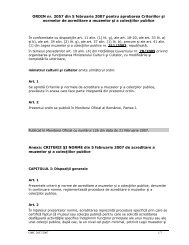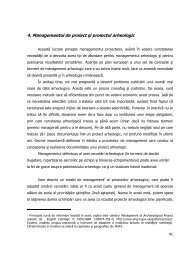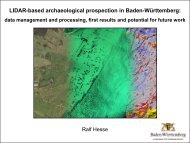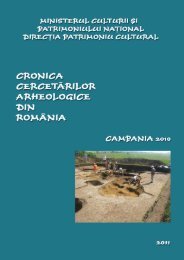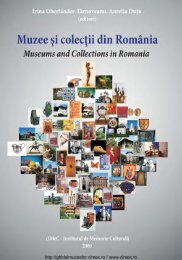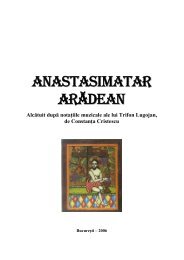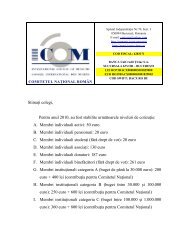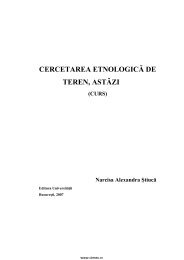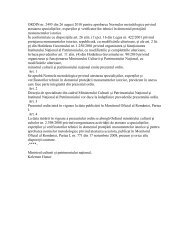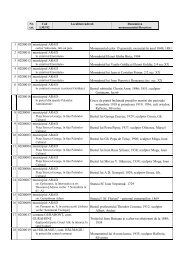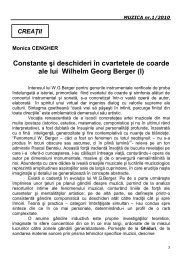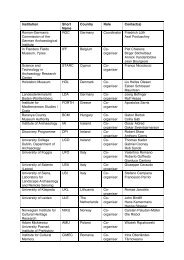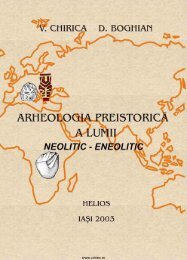pdf (15 MB) - cIMeC
pdf (15 MB) - cIMeC
pdf (15 MB) - cIMeC
You also want an ePaper? Increase the reach of your titles
YUMPU automatically turns print PDFs into web optimized ePapers that Google loves.
Cronica cercetărilor arheologice din România – campania 2006<br />
S-au identificat urme ale unor activităţi de amenajare a<br />
pantei Cetăţuiei, constând în terasări practicate în lutul viu<br />
databile în cea de a doua epocă a fierului (sec. II - I a. Chr.).<br />
Treptele sunt săpate în unghi de 90 de grade şi au o lărgime<br />
de 0,50 – 1 m. Din nivelul unei astfel de trepte porneşte un<br />
complex adâncit ce conţinea spre partea inferioară o jumătate<br />
din cupa unei fructiere de mari dimensiuni, lucrată la roată.<br />
Rămâne de stabilit rolul acestei gropi într-o posibilă structură<br />
de susţinere a treptelor.<br />
În partea superioară a pantei, la 8 m de buza actuală a<br />
platoului, au fost identificate trei complexe adâncite de formă<br />
cilindrică, cu diametru de 50 cm, dispuse aparent pe două<br />
şiruri paralele la limita dintre platou şi pantă. Cercetări<br />
ulterioare vor lămuri rolul lor într-un posibil sistem de<br />
fortificaţie. Aceste complexe au fost surprinse către limita lor<br />
inferioară ceea ce ar putea sugera o erodare puternică a<br />
marginii platoului care putea fi mai larg cu aprox. 5 m, pe de<br />
altă parte localizarea unei palisade pe pantă ar putea indica o<br />
modalitatea mai complexă de amenajare a platoului.<br />
În concluzie, se poate afirma că în epocă dacică terasa a<br />
fost amenajată în partea ei dinspre pantă (răsăriteană) prin<br />
săpătură în lutul viu, fiind în acea epocă mai largă cu cel puţin<br />
4 m (spre pantă). De aici panta urca abrupt, fiind probabil<br />
stabilizată prin terasare. Cercetări ulterioare ne vor furniza mai<br />
multe date despre complexul adâncit de mari dimensiuni,<br />
foarte bogat în material, din limita vestică a terasei.<br />
Şi în această campanie a fost recoltată o cantitate foarte<br />
mare de material arheologic, fie din complexe sau din stratul<br />
de cultură. Pe lângă piesele deosebite deja menţionate mai<br />
sus, amintim numeroase alte piese cum ar fi: trei fibule din fier,<br />
un inel de bronz, un fragment din vârful unei suliţe, un cuţit din<br />
fier, o mărgică, o verigă, cuie din fier, un calapod din lut şi<br />
numeroase fusaiole. De asemenea au fost descoperite<br />
numeroase vase parţial întregibile sau fragmentare provenind<br />
de la borcane, pithoi, ceşti – opaiţ, fructiere, castroane, boluri<br />
cu decor în relief sau fără decor, strecurători, vase în<br />
miniatură, etc.<br />
Pl. 24<br />
Note:<br />
1. Din colectivul lărgit de cercetare au mai făcut parte: Dan<br />
Costache (MJ Buzău), Dragos Măndescu (MJ Piteşti), Cătălin<br />
Constantin (CCA Bucureşti), Mihai Florea (MNIR) şi studenţii<br />
Alexandra Ghenghea, Radu Bârlă, Monica Nicolaescu, Florin<br />
Călian (FIB).<br />
2. Depunerea geto-dacică pare a suprapune aceste două<br />
complexe astfel că există posibilitatea ca cele două instalaţii de<br />
ardere să fie datate în sec. IV-III sau chiar în prima epocă a<br />
fierului.<br />
Bibliografie:<br />
Babeş, M., Problémes de la chronologie de la culture getodace<br />
à la lumière des fouilles de Cârlomăneşti, Dacia NS 19,<br />
1975, 125-139;<br />
Babeş, M., Statuetele geto-dace de la Cârlomăneşti, jud.<br />
Buzău, SCIVA 3, 1977, 319-352;<br />
Babeş, M., Paftale Latene târzii din sud-estul Europei, SCIVA,<br />
3, 1983, p. 196-221;<br />
Babeş, M., Cîrlomăneşti, în Enciclopedia arheologiei şi istoriei<br />
vechi a României, Bucureşti, 1994, p. 313-314;<br />
Gugiu-Măgureanu, D., Decorated Hearths Discovered in the<br />
Cârlomăneşti – Cetăţuia Settlement (the county of Buzău), în<br />
120<br />
volumul: Daco – geţii. 80 de ani de cercetări arheologice<br />
sistematice la cetăţile dacice din Munţii Orăştiei, Deva, 2004,<br />
p. 249-258;<br />
Cârlomăneşti, com. Verneşti, jud. Buzău, CCA 2002 p. 98-99;<br />
Idem, CCA 2003, p. 81-82, pl. 34;<br />
Idem, CCA 2004, p. 76-77, pl. 17;<br />
Idem, CCA 2005, p. 107-109;<br />
Idem, CCA 2006, p. 124-126, planşa 21;<br />
Abstract:<br />
The site is located on top of an oval, rather irregular<br />
shaped plateau, separated on its western and northern sides<br />
from the high Buzău River terrace by natural gills and having<br />
on its eastern and southern sides steep slopes, 25 m higher<br />
than the plain bellow.<br />
People had inhabited this plateau intensely, with short<br />
intermittences, during all the Bronze Age; afterwards, human<br />
communities had abandoned it for a longer period, but the<br />
habitation restarted during the classical period of the Geto –<br />
Dacians. During this interval, on the site, there passed<br />
sporadically First Iron Age communities, as the few uncovered<br />
ceramic sherds prove, and Getic populations, dated between<br />
the 4 th – 3 rd centuries B.C. who actually dug a few pits and left<br />
some ceramic material.<br />
The 2 nd – 1 st B.C. habitation was particularly intensive,<br />
confirmed by rather remarkable archaeological findings. Until<br />
now, several large structures have been researched: some few<br />
hundreds pits and many fireplaces, among which five were<br />
decorated, and some archaeological features difficult to<br />
categorize as agglomerations of ceramic sherds, ditches,<br />
areas of gravel.<br />
Surveys undertaken in the surrounding landscape of the<br />
site and a series of artifacts discovered during construction<br />
activities carried out in the neighbouring homesteads suggest<br />
that the Geto - Dacian habitation had been considerably larger.<br />
All these data attest the existence of a powerful dava in the site<br />
of Cârlomăneşti, with the plateau “Cetăţuia” as its central<br />
place.<br />
In the 2006 campaign, we continued to excavate the V4b<br />
research area, aiming to finalize the Dacian depositional layer.<br />
In addition, we extended the S1 archaeological section located<br />
on the T1 terrace, in order to uncover possible fortification<br />
traces of the plateau and understand the way the terrace was<br />
structured.<br />
In the V4b excavation area, divided in two 9 x 9 m smaller<br />
surfaces, we continued to research features discovered in the<br />
past campaigns (Feature 18 – cult edifice with Feature 28 –<br />
decorated fireplace; the 3 postholes that helped sustaining the<br />
Feature 1’s roof – the edifice with absidae; a fireplace, a ditch<br />
and 19 pits). In addition, 23 new features were discovered (16<br />
pits, 3 ditches, 2 firing installations, a post hole and two<br />
superposed fireplaces, one decorated), dated in the 2 nd – 1 st<br />
B.C., and partially, a Bronze Age fireplace.<br />
In 2006, the excavations continued on the T1 terrace –<br />
triangular shaped, 1000 square metres surface, extended from<br />
“Cetăţuia” hill towards west - north-west. This small terrace<br />
connects the main plateau with steep slopes, with the<br />
surrounding hilly relief in the north and west. At present, it<br />
represents the easiest way to reach the upper site. In 2005, we<br />
projected the S1 archaeological surface, in order to section the<br />
entire length of the terrace and slope of the site from base to<br />
the upper plateau. In the 2006 campaign, the section was




